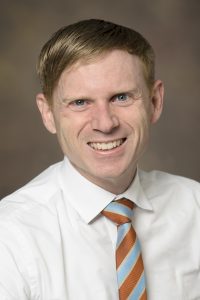Volunteer Goes From Fresh Out of Training to ‘Amazing’
By Rodney Campbell, ABR Communications Manager
2024;17(6):9

When asked to describe ABR volunteer Ryan Avery, MD, his committee chair keeps it simple.
“He’s amazing,” said Derek Johnson, MD, who leads the Diagnostic Radiology Nuclear Radiology Subspecialty Committee.
Dr. Avery, the chief of nuclear medicine in Northwestern University’s Feinberg School of Medicine’s Department of Radiology and an associate professor of nuclear medicine, has been an ABR volunteer for five years. He said he was excited about the opportunity to get involved as a radiologist who was fresh out of training.
“I thought it would be a great opportunity because I was still relatively junior in my career,” he said. “It didn’t feel like it was that long ago when I went through the process of taking my certification exam. To move and transition to that component was a huge opportunity for me from the educational perspective of being an academic radiologist.”
Dr. Avery believes that working with residents makes him a better question writer, earning that high praise from Dr. Johnson. Ongoing interaction with trainees gives him a better idea of what qualifies as fair and relevant content.
“It’s a continual refinement of my skills and their skills,” he said. “Residents ask good questions. They have curiosities and you can see where they get confused over certain things, which is nice because as I write questions, I know the issues that are out there.”
Working at Northwestern also gives Dr. Avery the opportunity to teach interventional radiology residents working their way through the program.
“You see their questions and they’re intrigued about radioembolization therapies,” he said. “You can see where their knowledge is and where it is lacking.”
An essential element of training is ensuring that instruction keeps up with the times. Dr. Avery points out advancements in PET technology over the past several years as an example.
Volunteers need to look ahead when developing content, especially in a constantly evolving field. He said ABR volunteers do that as standard practice.
“You need to focus on where things are going,” he said. “If trainees are picking up an older edition of a textbook or a study guide, they’re learning data that’s erroneous because the literature has moved past it. It’s nice to see how much the ABR tries to make sure that these examinations are not reflecting things that have passed.”
Dr. Avery uses his volunteer experience to stay current on those changes in nuclear medicine. His exam committee is filled with experts from the field, allowing him to learn as he develops and reviews content.
“It’s been very humbling and enjoyable,” he said. “It’s nice being someone who has to be continuously up to speed with the literature and the practices of nuclear medicine.”
Dr. Avery considered other subspecialties before taking the nuclear medicine path. He said he’s happy he chose this branch because cancer treatment options have grown over the past decade.
He’s happy to see his subspecialty growing in importance.
“I was very lucky about 10 years ago to see that nuclear medicine was about to get out of the basement,” Dr. Avery said. “It’s an extremely intriguing time where PET CT is not synonymous with FDG PET. Even more exciting is that PET CT is becoming the gateway for an exponentially growing number of theranostic agents. All of a sudden, I have to find my white coat and get ready because I’m seeing patients again. It’s kept me very busy and interested and excited.”


